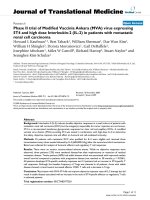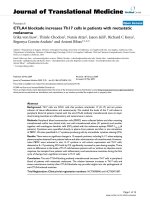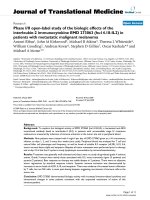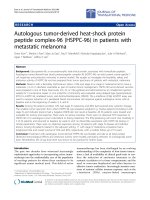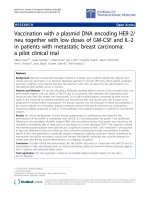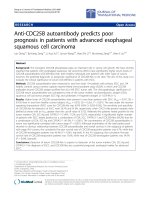Pretreatment neutrophil-to-lymphocyte ratio predicts the prognosis in patients with metastatic prostate cancer
Bạn đang xem bản rút gọn của tài liệu. Xem và tải ngay bản đầy đủ của tài liệu tại đây (663.05 KB, 6 trang )
Kawahara et al. BMC Cancer (2016) 16:111
DOI 10.1186/s12885-016-2134-3
RESEARCH ARTICLE
Open Access
Pretreatment neutrophil-to-lymphocyte
ratio predicts the prognosis in patients with
metastatic prostate cancer
Takashi Kawahara1,2*† , Yumiko Yokomizo1†, Yusuke Ito1, Hiroki Ito1, Hitoshi Ishiguro3, Jun-ichi Teranishi2,
Kazuhide Makiyama1, Yasuhide Miyoshi2, Hiroshi Miyamoto4, Masahiro Yao1 and Hiroji Uemura2
Abstract
Background: The neutrophil-to-lymphocyte ratio (NLR), a simple marker of the systemic inflammatory response in
critical care patients, has been suggested as an independent prognostic factor for several solid malignancies. We
investigated the utility of pretreatment NLR as a prognosticator in patients who presented with metastatic prostate
cancer.
Methods: We first investigated the correlation between NLR and prostate-specific antigen (PSA) levels in 1464 men
who had both tests and were found to have prostate cancer on their biopsies at our institution from 1999 to 2015.
We then assessed the relationship between pretreatment NLR and the prognosis in 48 patients who were
diagnosed with prostate cancer metastasized to the lymph node and/or bone.
Results: The NLR value was significantly elevated in men with higher PSA than in those with lower PSA (p < 0.001).
In patients with metastatic prostate cancer, NLR (cut-off point of 3.37 determined by the AUROC curve) was
correlated with both cancer-specific (p = 0.018) and overall (p = 0.008) survivals.
Conclusions: Pretreatment NLR may function as a new biomarker that precisely predicts the prognosis in patients
with metastatic prostate cancer.
Keywords: Prostate cancer, Biomarker, Neutrophil-to-lymphocyte ratio, Metastasis
Background
Prostate cancer is the most common malignancy in men.
The PSA screening test is widely available in Japan, but a
large number of patients still present with advanced stage
prostate cancer. Although most of prostate cancers with
metastatic lesions respond to initial androgen ablation
therapy, responders ultimately develop progressive disease
of hormone refractory cancer.
The neutrophil-to-lymphocyte ratio (NLR) has been
suggested as a simple marker of the systemic inflammatory response in critical care patients [1]. It has also been
reported as an independent prognostic factor for several
* Correspondence:
†
Equal contributors
1
Department of Urology, Yokohama City University, Graduate School of
Medicine, Yokohama, Japan
2
Departments of Urology and Renal Transplantation, Yokohama City Medical
Center, Yokohama, Japan
Full list of author information is available at the end of the article
solid malignancies [2–11]. Importantly, NLR can easily be
calculated from routine complete blood counts (CBCs) in
peripheral blood samples [9, 10].
The utility of NLR as a potential biomarker for prostate
cancer has been investigated [12]. However, most of these
have included patients with advanced tumor, such as
castration-resistant prostate cancer, or those who received
second-line chemotherapy. To our knowledge, no studies
have assessed pretreatment NLR as a predictive marker of
survival in patients who were diagnosed with metastatic
prostate cancer.
Methods
Patients and clinical and laboratory assessments
A total of 73,637 CBCs examinations that included absolute
neutrophil and lymphocyte counts were performed in
9782 men at the Department of Urology, Yokohama City
University Hospital (Yokohama, Japan) from 1999 to
© 2016 Kawahara et al. Open Access This article is distributed under the terms of the Creative Commons Attribution 4.0
International License ( which permits unrestricted use, distribution, and
reproduction in any medium, provided you give appropriate credit to the original author(s) and the source, provide a link to
the Creative Commons license, and indicate if changes were made. The Creative Commons Public Domain Dedication waiver
( applies to the data made available in this article, unless otherwise stated.
Kawahara et al. BMC Cancer (2016) 16:111
2015. Both CBCs and PSA levels were examined in 1464
patients who were diagnosed with prostate cancer, including 48 presented with prostate cancer metastasized to the
lymph node and/or bone. As the initial treatment, 42
(87.5 %) received combine androgen blockade, 8 (18.8 %)
received zoledronic acid, 3 (7.1 %) underwent radical prostatectomy, and none of the patients received radiation
therapy. All patients had no systemic inflammation at the
time of biopsy. This study was approved by the Institutional Review Board of the Yokohama City University
Medical Center. Written informed consent was obtained
from all patients.
Statistical analysis
The patients’ characteristics were analyzed using the
Mann–Whitney U, chi-square, and one factor ANOVA
tests. Any correlations between the variables were determined by the Spearman correlation analysis. The NLR
cut-off value was evaluated by the AUROC curve. The
Kaplan-Meier product limit estimator was used to estimate cancer-specific survival (CSS) and overall survival
(OS). Survival duration was defined as the time between
the dates of pathological diagnosis and death. A log-rank
test was performed for comparison. The statistical analyses were performed using the Graph Pad Prism software program (Graph Pad Software, La Jolla, CA, USA).
Statistical significance was determined as p < 0.05.
Page 2 of 6
Table 1 Characteristics of 1464 patients with prostate cancer
Variables
n (%), or median (range, mean ± SD)
PSA <4
Number of patients
738 (50.4 %)
Age (y)
76 (35–99, 75.3 ± 9.0)
WBC (/mL)
5800 (2000–16,100, 6321.3 ± 2203.3)
Neutrophil (%)
58.8 (4.5–89.0, 59.5 ± 10.3)
Lymphocyte (%)
29.0 (1.0–60.5, 28.6 ± 8.9)
NLR
2.02 (0.09–44.5, 2.57 ± 2.33)
4 ≤ PSA <20
Number of patients
519 (35.5 %)
Age (y)
73 (44–99, 72.8 ± 8.2)
WBC (/mL)
5900 (1100–22,800, 6286.1 ± 2056.8)
Neutrophil (%)
60.5 (3.0–90.0, 60.6 ± 10.4)
Lymphocyte (%)
28.6 (3.0–91.0, 28.6 ± 9.2)
NLR
2.11 (0.03–28.67, 2.57 ± 1.99)
20 ≤ PSA < 100
Number of patients
113 (7.7 %)
Age (y)
76 (54–104, 76.2 ± 8.9)
WBC (/mL)
6000 (1400–28,500, 6379.7 ± 3919.7)
Neutrophil (%)
61.4 (7.0–96.7, 61.6 ± 13.1)
Lymphocyte (%)
27.7 (2.6–82.5, 26.9 ± 11.9)
NLR
2.21 (0.08–37.19, 3.64 ± 4.78)
100 ≤ PSA < 500
Results
Number of patients
53 (3.6 %)
NLR is positively associated with PSA
Age (y)
77 (59–99, 78.0 ± 8.6)
A total of 1464 patients with prostate cancer were analyzed in this study. Their background information, including age, white blood cell count (/mL), neutrophil
(%), lymphocyte (%), and NLR are described in Tables 1
and 2. In patients with PSA of <4 ng/mL, the mean NLR
was 2.57, which was increased up to 6.43 in those with
PSA of ≥500 ng/mL (Fig. 1). Therefore, the NLR values
were significantly higher in the high PSA level groups
(p < 0.001). On the other hand, because of the exponential increases in the PSA levels, the correlation coefficient was not significantly different (r = 0.09, p = 0.08).
NLR predicts the survival of metastatic prostate cancer
CBCs were examined in 48 metastatic prostate cancer patients before undergoing prostate needle biopsy. The basic
characteristics, including age, initial PSA, and Gleason
score, are shown in Table 3. There were no statistically
significant correlations between NLR and each of clinicopathologic feature. The median and mean (± SD) followup times were 61 and 55.9 (±34.0) months, respectively.
Nineteen patients (39.6 %) died of prostate cancer.
We created an AUROC curve to determine the NLR
cut-off value for predicting the prognosis. The cut-off
value was determined to be 3.37 (Fig. 2). Patients with
WBC (/mL)
6300 (1000–26,400, 6664.2 ± 3501.1)
Neutrophil (%)
66.0 (25.5–95, 64.1 ± 15.1)
Lymphocyte (%)
22.5 (2.5–61.0, 23.3 ± 11.9)
NLR
2.83 (0.42–38.00, 4.60 ± 5.75)
500 ≤ PSA
Number of patients
41 (2.8 %)
Age (y)
79 (60–95, 77.3 ± 9.1)
WBC (/mL)
6400 (2300–48,800, 7973.2 ± 6909.6)
Neutrophil (%)
69.0 (29.0–60.0, 67.0 ± 14.8)
Lymphocyte (%)
20.0 (1.5–58.0, 22.2 ± 13.0)
NLR
3.33 (0.50–60.00, 6.43 ± 10.49)
high NLR showed significantly poorer CSS (p = 0.018)
and OS (p = 0.008), compared with those with low NLR
(Fig. 3).
Discussion
PSA was also found to be positively correlated with the
NLR in patients with prostate cancer. McDonald et al.
hypothesized that the NLR might reflect the balance between innate (neutrophils) and adaptive (lymphocytes)
immune responses; its association with higher serum
Kawahara et al. BMC Cancer (2016) 16:111
Page 3 of 6
Table 2 Patients’ background
Variables
Total
Low NLR (<3.37, n = 36)
High NLR (≥3.37, n = 12)
p value
Age (yr)
70.5 (71.33 ± 6.92)
70 (70.7 ± 7.2)
73.5 (73.3 ± 5.9)
0.234
iPSA (ng/mL)
82.2 (605.1 ± 1446.3)
82.2 (436.2 ± 1090.7)
102.1 (1111.7 ± 2186.0)
0.322
Gleason’s Sum ≤ 6
2 (4.2 %)
1 (2.8 %)
1 (8.3 %)
0.156
Gleason’s Sum = 7
14 (29.2 %)
13 (36.1 %)
1 (8.3 %)
Gleason’s Sum ≥ 8
32 (66.7 %)
22 (61.1 %)
10 (83.3 %)
2
6 (12.5 %)
4 (11.1 %)
2 (16.7 %)
3
27 (56.3 %)
22 (61.1 %)
5 (41.7 %)
4
15 (31.3 %)
10 (27.8 %)
5 (41.7 %)
0
21 (43.8 %)
16 (44.4 %)
5 (41.7 %)
1
27 (56.3 %)
20 (55.6 %)
7 (58.3 %)
0
13 (27.1 %)
12 (33.3 %)
1 (8.3 %)
1
35 (72.9 %)
24 (66.7 %)
11 (91.7 %)
2.49 (2.93 ± 1.66)
2.17 (2.25 ± 0.64)
4.26 (4.98 ± 2.08)
Pathological Grade
Clinical T Stage
0.501
Clinical N Stage
0.867
Clinical M Stage
NLR
0.091
<0.001
median (mean ± SD)
PSA levels might indicate impairment in the adaptive
host’s ability to control inflammation [12]. The PSA level
was shown to be a prognostic factor in prostate cancer
patients with a PSA of >500 ng/mL, and higher PSA
levels (>1000 or 5000 ng/mL) were associated with a
poorer outcome [13]. Our results also support those
data.
Our results showed pretreatment NLR to be a predictor of survival in patients presenting with metastatic
prostate cancer. Increasing evidence shows that the presence of systemic inflammation is correlated with poorer
CSS in various solid organ tumors [3, 14–19]. Moreover,
nonsteroidal anti-inflammatory medications have been
suggested to reduce the risk of developing prostate
cancer, implying its critical correlation with
Table 3 Characteristics of 48 patients with metastatic prostate
cancer
Variables
Median (range, mean ± SD)
Age (y)
70.5 (51–88, 71.33 ± 6.92)
Initial PSA (ng/mL)
82.16 (8.2–7285, 605.06 ± 1446.25)
Pathological Grade
Gleason Score ≤ 6
2 (4.2 %)
Gleason Score = 7
14 (29.2 %)
Gleason Score ≥ 8
32 (66.7 %)
Clinical T Stage
2
6 (12.5 %)
3
27 (56.3 %)
4
15 (31.3 %)
Clinical N Stage
0
21 (43.8 %)
1
27 (56.3 %)
Clinical M Stage
Fig. 1 Association between NLR and PSA levels. Each NLR value
represents the mean + SEM
0
13 (27.1 %)
1
35 (72.9 %)
NLR
2.49 (0.84–10.56, 2.93 ± 1.66)
Kawahara et al. BMC Cancer (2016) 16:111
Page 4 of 6
Fig. 2 The AUROC for the NLR (a: Cancer-Specific Survival, b: Overall Survival)
inflammation [14, 15]. Markers of systemic inflammation, including the NLR, have also been associated with
elevated PSA levels in men without known prostatic disease [12]. It has previously been demonstrated that the
presence of an inflammatory response can be determined by not only C-reactive protein expression but also
NLR elevation [1, 3, 20].
We retrospectively investigated the NLR in our clinical database. CBCs are usually determined during
clinical check-ups, and thus it is possible to apply the
NLR to all patients, both preoperatively and postoperatively. The NLR can be simply calculated from routine
CBCs with differentials [21]. CBCs are usually examined in the clinical check-up, and NLR can be applied
to virtually all patients either before or after surgery/
medical treatment. The NLR that has been proposed to
estimate the magnitude of systemic inflammation in
cancer patients is thus an easily and inexpensively
measured prognostic marker [2, 22–24].
The proposed mechanisms involving the relationship
between NLR elevation and tumor progression include
the increased supply of growth factors, survival factors,
pro-tumorigenic factors, and extracellular matrixmodifying enzymes (which can facilitate invasion and
metastasis), and inductive signals that may lead to
epithelial-to-mesenchymal transition [21, 25]. Patients
with an elevated NLR have also been shown to exhibit a
lymphocyte-mediated immune response to malignancy,
suggesting that NLR elevation could be associated with
an increased potential for tumor progression and a
worse prognosis [26, 27]. The interaction between the
tumor and the host immune system promotes tumor cell
proliferation and metastasis, and activates the inflammatory cascade in the host, which leads to the further deterioration of the general condition of cancer patients [28].
Studies have proposed that tumor-associated neutrophils
have two different states: anti-tumorigenic (N1-phenotype) and a pro-tumorigenic (N2-phenotype) [29, 30].
Fig. 3 The Association of patient outcomes with NLR (a: Cancer-Specific Survival, b: Overall Survival)
Kawahara et al. BMC Cancer (2016) 16:111
CD8-positive lymphocytes are also known to play an antitumorigenic role [29, 31].
The present study is associated with some limitations
due to its retrospective nature. Our patients received a
variety of prostate cancer therapies including traditional
hormonal treatment as well as several new drugs. Although the treatment options were heterogeneous, we
found the NLR to be a new biomarker that was associated with patient outcomes. Thus, pretreatment NLR
may be a useful prognosticator in patients with metastatic prostate cancer. The second one is that NLR may
be affected by infection, systemic inflammation and
medication, however, such conditions may not have affected the NLR in our cohort since the NLR was obtained at the time of biopsy and any cases with infection
or systemic inflammation were excluded from the analysis. In addition, none of the patients received any prebiopsy medication that is known to affect the NLR. The
third limitation is the limited sample size. As a result,
further study with a larger group of patients is needed.
Conclusions
In conclusion, pretreatment NLR may function as a new
biomarker that precisely predicts the prognosis in
patients with metastatic prostate cancer.
Availability of supporting data
Due to ethical restrictions, the raw data underlying this
paper is available upon request to the corresponding
author.
Abbreviations
CBCs: complete blood counts; CSS: cancer-specific survival;
NLR: neutrophil-to-lymphocyte ratio; OS: overall survival; PSA:
prostate-specific antigen.
Competing interests
The authors declare that they have no competing interests.
Authors’ contributions
Conceived and designed the experiments: TK, YY, HM, HU. Performed the
experiments: YI, HIs, JT, KM, YM. Wrote the paper: TK, HIt, HM, MY. All authors
have read and approved the manuscript.
Acknowledgments
Grants from the Uehara Memorial Foundation, the Tokyo Biochemical Research
Foundation, the Japanese Foundation for Research and Promotion of Endoscopy,
and an International Exchange Grant from Kato Memorial Bioscience Foundation
were provided to T.K. There are no applicable grant numbers.
Author details
1
Department of Urology, Yokohama City University, Graduate School of
Medicine, Yokohama, Japan. 2Departments of Urology and Renal
Transplantation, Yokohama City Medical Center, Yokohama, Japan.
3
Photocatalyst Group, Special Research Laboratory, Kanagawa Academy of
Science and Technology, Kawasaki, Japan. 4Departments of Pathology and
Urology, Johns Hopkins University School of Medicine, Baltimore, USA.
Received: 18 October 2015 Accepted: 7 February 2016
Page 5 of 6
References
1. Zahorec R. Ratio of neutrophil to lymphocyte counts–rapid and simple
parameter of systemic inflammation and stress in critically ill. Bratisl Lek
Listy. 2001;102(1):5–14.
2. Xue P, Kanai M, Mori Y, Nishimura T, Uza N, Kodama Y, et al. Neutrophil-tolymphocyte ratio for predicting palliative chemotherapy outcomes in
advanced pancreatic cancer patients. Cancer Med. 2014;3(2):406–15.
3. Gomez D, Morris-Stiff G, Toogood GJ, Lodge JP, Prasad KR. Impact of
systemic inflammation on outcome following resection for intrahepatic
cholangiocarcinoma. J Surg Oncol. 2008;97(6):513–8.
4. Chua W, Charles KA, Baracos VE, Clarke SJ. Neutrophil/lymphocyte ratio
predicts chemotherapy outcomes in patients with advanced colorectal
cancer. Br J Cancer. 2011;104(8):1288–95.
5. Azab B, Bhatt VR, Phookan J, Murukutla S, Kohn N, Terjanian T, et al.
Usefulness of the neutrophil-to-lymphocyte ratio in predicting short- and
long-term mortality in breast cancer patients. Ann Surg Oncol. 2012;19(1):
217–24.
6. Dalpiaz O, Pichler M, Mannweiler S, Martin Hernandez JM, Stojakovic T,
Pummer K, et al. Validation of the pretreatment derived neutrophillymphocyte ratio as a prognostic factor in a European cohort of patients
with upper tract urothelial carcinoma. Br J Cancer. 2014;110(10):2531–6.
7. Jung MR, Park YK, Jeong O, Seon JW, Ryu SY, Kim DY, et al. Elevated
preoperative neutrophil to lymphocyte ratio predicts poor survival following
resection in late stage gastric cancer. J Surg Oncol. 2011;104(5):504–10.
8. Demirtas A, Sabur V, Akinsal EC, Demirci D, Ekmekcioglu O, Gulmez I, et al.
Can neutrophil-lymphocyte ratio and lymph node density be used as
prognostic factors in patients undergoing radical cystectomy? Sci World J.
2013;2013:703579.
9. Walsh SR, Cook EJ, Goulder F, Justin TA, Keeling NJ. Neutrophil-lymphocyte
ratio as a prognostic factor in colorectal cancer. J Surg Oncol. 2005;91(3):181–4.
10. Ohno Y, Nakashima J, Ohori M, Hatano T, Tachibana M. Pretreatment
neutrophil-to-lymphocyte ratio as an independent predictor of recurrence in
patients with nonmetastatic renal cell carcinoma. J Urol. 2010;184(3):873–8.
11. Rosenberg L, Lawlor GO, Zenlea T, Goldsmith JD, Gifford A, Falchuk KR, et al.
Predictors of endoscopic inflammation in patients with ulcerative colitis in
clinical remission. Inflamm Bowel Dis. 2013;19(4):779–84.
12. McDonald AC, Vira MA, Vidal AC, Gan W, Freedland SJ, Taioli E. Association
between systemic inflammatory markers and serum prostate-specific
antigen in men without prostatic disease - the 2001–2008 National Health
and Nutrition Examination Survey. Prostate. 2014;74(5):561–7.
13. Sugihara T, Yu C, Kattan MW, Yasunaga H, Ihara H, Onozawa M, et al. Long-term
survival of extremely advanced prostate cancer patients diagnosed with
prostate-specific antigen over 500 ng/ml. Jpn J Clin Oncol. 2014;44(12):1227–32.
14. Kawahara T, Ishiguro H, Hoshino K, Teranishi J, Miyoshi Y, Kubota Y, et al.
Analysis of NSAID-activated gene 1 expression in prostate cancer. Urol Int.
2010;84(2):198–202.
15. Ishiguro H, Kawahara T. Nonsteroidal anti-inflammatory drugs and prostatic
diseases. BioMed Res Int. 2014;2014:436123.
16. Coussens LM, Werb Z. Inflammation and cancer. Nature. 2002;420(6917):
860–7.
17. Gunter MJ, Stolzenberg-Solomon R, Cross AJ, Leitzmann MF, Weinstein S,
Wood RJ, et al. A prospective study of serum C-reactive protein and
colorectal cancer risk in men. Cancer Res. 2006;66(4):2483–7.
18. Zhang K, Kaufman RJ. From endoplasmic-reticulum stress to the
inflammatory response. Nature. 2008;454(7203):455–62.
19. Kawahara T, Miyoshi Y, Sekiguchi Z, Sano F, Hayashi N, Teranishi J, et al. Risk
factors for metastatic castration-resistant prostate cancer (CRPC) predict
long-term treatment with docetaxel. PLoS One. 2012;7(10):e48186.
20. McMillan DC, Canna K, McArdle CS. Systemic inflammatory response
predicts survival following curative resection of colorectal cancer. Br J Surg.
2003;90(2):215–9.
21. Hermanns T, Bhindi B, Wei Y, Yu J, Noon AP, Richard PO, et al. Pre-treatment
neutrophil-to-lymphocyte ratio as predictor of adverse outcomes in patients
undergoing radical cystectomy for urothelial carcinoma of the bladder.
Br J Cancer. 2014;111(3):444–51.
22. Stotz M, Gerger A, Eisner F, Szkandera J, Loibner H, Ress AL, et al. Increased
neutrophil-lymphocyte ratio is a poor prognostic factor in patients with
primary operable and inoperable pancreatic cancer. Br J Cancer. 2013;109(2):
416–21.
23. Smith RA, Bosonnet L, Raraty M, Sutton R, Neoptolemos JP, Campbell F,
et al. Preoperative platelet-lymphocyte ratio is an independent significant
Kawahara et al. BMC Cancer (2016) 16:111
24.
25.
26.
27.
28.
29.
30.
31.
Page 6 of 6
prognostic marker in resected pancreatic ductal adenocarcinoma. Am J
Surg. 2009;197(4):466–72.
Proctor MJ, Morrison DS, Talwar D, Balmer SM, O’Reilly DS, Foulis AK, et al.
An inflammation-based prognostic score (mGPS) predicts cancer survival
independent of tumour site: a Glasgow Inflammation Outcome Study. Br J
Cancer. 2011;104(4):726–34.
Hanahan D, Weinberg RA. Hallmarks of cancer: the next generation. Cell.
2011;144(5):646–74.
Gondo T, Nakashima J, Ohno Y, Choichiro O, Horiguchi Y, Namiki K, et al.
Prognostic value of neutrophil-to-lymphocyte ratio and establishment of
novel preoperative risk stratification model in bladder cancer patients
treated with radical cystectomy. Urology. 2012;79(5):1085–91.
Cho H, Hur HW, Kim SW, Kim SH, Kim JH, Kim YT, et al. Pre-treatment neutrophil
to lymphocyte ratio is elevated in epithelial ovarian cancer and predicts survival
after treatment. Cancer Immunol Immunother. 2009;58(1):15–23.
Mantovani A, Allavena P, Sica A, Balkwill F. Cancer-related inflammation.
Nature. 2008;454(7203):436–44.
Wang J, Jia Y, Wang N, Zhang X, Tan B, Zhang G, et al. The clinical
significance of tumor-infiltrating neutrophils and neutrophil-to-CD8+
lymphocyte ratio in patients with resectable esophageal squamous cell
carcinoma. J Transl Med. 2014;12:7.
Fridlender ZG, Sun J, Kim S, Kapoor V, Cheng G, Ling L, et al. Polarization of
tumor-associated neutrophil phenotype by TGF-beta: “N1” versus “N2” TAN.
Cancer Cell. 2009;16(3):183–94.
Williams MA, Bevan MJ. Effector and memory CTL differentiation. Annu Rev
Immunol. 2007;25:171–92.
Submit your next manuscript to BioMed Central
and we will help you at every step:
• We accept pre-submission inquiries
• Our selector tool helps you to find the most relevant journal
• We provide round the clock customer support
• Convenient online submission
• Thorough peer review
• Inclusion in PubMed and all major indexing services
• Maximum visibility for your research
Submit your manuscript at
www.biomedcentral.com/submit

